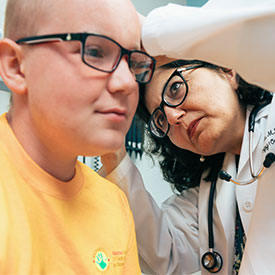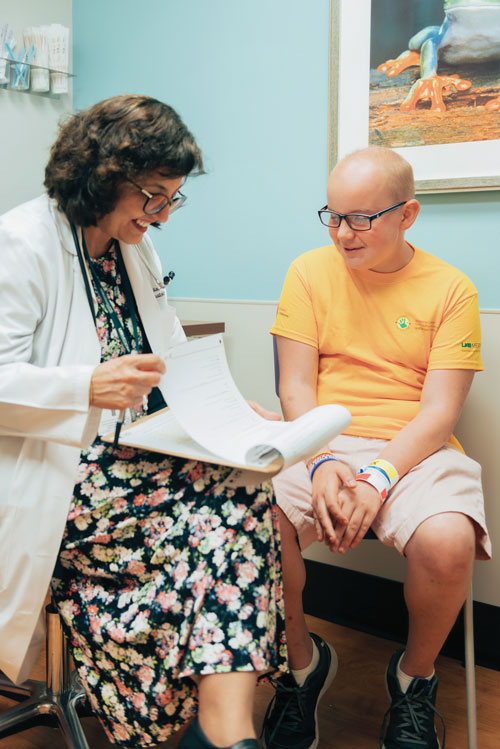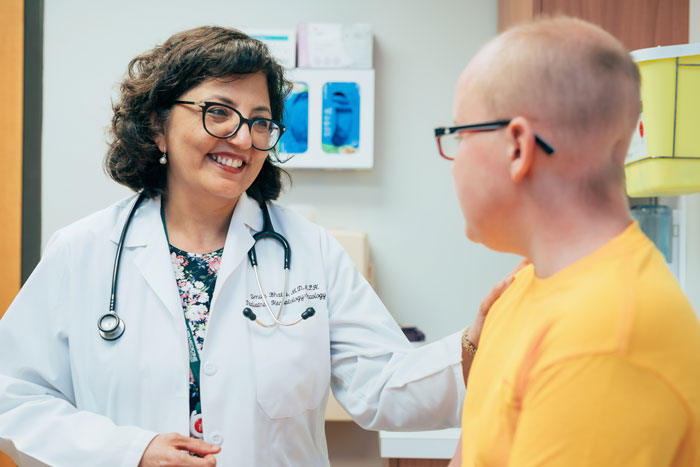 As of January 2019, the National Cancer Institute (NCI) estimates that there are 16.9 million cancer survivors living in the U.S. By 2029, that number is expected to increase by about 29% to 21.7 million cancer survivors. These numbers speak volumes to the treatment advances taking place every day.
As of January 2019, the National Cancer Institute (NCI) estimates that there are 16.9 million cancer survivors living in the U.S. By 2029, that number is expected to increase by about 29% to 21.7 million cancer survivors. These numbers speak volumes to the treatment advances taking place every day.
For physician-scientists like Smita Bhatia, M.D., MPH, director of the School of Medicine’s Institute for Cancer Outcomes and Survivorship, vice chair for outcomes research in the Department of Pediatric Oncology, and associate director for outcomes research at the O’Neal Comprehensive Cancer Center at UAB, there’s more to the story. Bhatia’s work is in the fast-growing field of cancer survivorship. She focuses on what happens to patients post-cancer: What are their long-term prognoses? How can we create the most positive outcomes for them?
Meeting the Need
Bhatia grew up in India and received the majority of her medical education at the All India Institute of Medical Sciences in New Delhi, as did her husband, Ravi Bhatia, M.D. Since the Bhatias joined UAB from City of Hope in Duarte, California, in 2015, Ravi has served as director of the Division of Hematology-Oncology and was recently appointed interim director of the O’Neal Comprehensive Cancer Center at UAB.
Both Bhatias developed an interest in oncology early on and came to the U.S. for specialized training, eventually landing at the University of Minnesota. There, Smita says she found her calling. “Beginning my clinical research career in cancer survivorship was serendipity. I was at the right place at the right time,” she says. At Minnesota, she trained under Les Robison, M.D., (now at St. Jude Children’s Research Hospital), a pioneer in the field. “I quickly realized how rewarding it was to learn from cancer survivors. There was so much to be done to improve their lives that I didn’t look back,” she says.
 At City of Hope, Bhatia made significant scientific contributions toward identifying chronic health issues among cancer survivors, including patients undergoing hematopoietic cell (blood stem cell) transplantation. She established multidisciplinary survivorship clinics and a Department of Population Sciences.
At City of Hope, Bhatia made significant scientific contributions toward identifying chronic health issues among cancer survivors, including patients undergoing hematopoietic cell (blood stem cell) transplantation. She established multidisciplinary survivorship clinics and a Department of Population Sciences.
Negative outcomes often occur from the very treatments that help save cancer patients’ lives in the first place—like chemotherapy and radiation—as well as genetic factors.
Many survivors face complications that can be fatal. “The most common (risk) in childhood cancer survivors is the development of new cancers,” says Bhatia. While at the University of Minnesota, Bhatia and her colleagues discovered that adolescent girls undergoing chest radiation for Hodgkin lymphoma treatment had an increased risk of developing radiation-related breast cancer. This finding resulted in reducing radiation doses in this patient group and creating clinical trials to develop risk-reduction strategies for girls treated with chest radiation.
People who survive cancer at older ages face different challenges. “Our team, led by Dr. Kelly Kenzik, has shown that cardiovascular disease is the most prevalent chronic health condition among older cancer survivors. Our cancer survivors are at a two-fold higher risk of new-onset cardiovascular disease than the general population,” Bhatia says.
The long-term outcomes are not consistent across the board either. “Not everyone has the same risk,” she says. “The risk varies by the treatment dose, the presence of other medical conditions, and one’s genetics.”
Accuracy Improves Outcomes
Bhatia and her colleagues work to pinpoint the risks and their causes as accurately as possible while also finding ways to improve outcomes. One focus is on educating survivors about their risks. Bhatia says she understands that this can be a difficult discussion for patients in the beginning. “After having finished their treatments, they’re ready to look forward to the rest of their lives,” she says. “But that’s the time when we need to start discussing these issues.” She stresses that better-educated patients are more likely to continue with the all-important follow-up care.
“Knowing that they are at risk for these complications may cause cancer survivors anxiety, but it also enables them to be the best advocates for their own care,” Bhatia says.
“They need to be in communication with their health care providers over the long-term so they can be screened for complications. If the information is relayed to them in a positive way—that we are here to work with them in order to mitigate the risks—then we become their partners in making sure that they take care of themselves.”
To that end, Bhatia works closely with UAB’s cancer survivorship clinics. One includes the Taking on Life After Cancer (TLC) Clinic, which is dedicated to childhood cancer survivors. A second clinic is designed for breast cancer survivors, and UAB is in the process of developing a third for head and neck cancer survivors.
Bhatia continues to focus on understanding the causes of cancer complications more precisely, which includes discovering why new cancers develop after treatment and determining how to reduce their occurrence in the first place.
She is also studying how personalized cancer treatments can minimize potential damage to the body. In 2018, the National Cancer Institute (NCI) awarded Bhatia the highly competitive Outstanding Investigator Award. She received a $6.2 million grant to continue her research in this area.
“I’m trying to identify who is at the highest risk for developing complications,” she says. “If we can identify the patient’s level of risk for developing complications at the time of cancer diagnosis, we can tailor their treatment accordingly. If radiation is likely to cause stroke in a patient, we would recommend using alternative treatments. If the patient is at low risk for radiation-related stroke, it would be fine to proceed with radiation. Ultimately, we want to develop tailored treatments for these patients so they can live long lives without treatment complications.”
Future Explorations
Bhatia has won a number of other awards for her research, including the Northwestern Mutual Award for Excellence in Childhood Cancer Survivorship from the American Society of Pediatric Oncology/Hematology in 2018. The annual award recognizes an individual who translates research findings into intervention-based approaches and/or makes outstanding contributions to childhood cancer survivors’ clinical care.
Earlier this year, the NCI awarded Bhatia’s research team a $6.38 million grant to determine the long-term morbidity burden of blood cancer patients treated with or without blood or marrow transplantation (BMT). In 2018, an estimated 175,000 people were diagnosed with a blood cancer—such as leukemia, myeloma, or lymphoma—in the U.S. These cancers are typically managed through high-intensity chemotherapy with or without radiation. Patients with progressive disease or high risk of relapse are treated with even higher-intensity chemotherapy/radiation and BMT.
 “Steady improvements in outcome have resulted in a growing number of BMT survivors, a population uniquely vulnerable to long-term, life-threatening chronic morbidity,” says Bhatia, who is the study’s principal investigator. “Having a better understanding of post-BMT health care needs could result in deploying targeted strategies that yield better quality of survival and reduced utilization of health care resources.”
“Steady improvements in outcome have resulted in a growing number of BMT survivors, a population uniquely vulnerable to long-term, life-threatening chronic morbidity,” says Bhatia, who is the study’s principal investigator. “Having a better understanding of post-BMT health care needs could result in deploying targeted strategies that yield better quality of survival and reduced utilization of health care resources.”
The study will construct a cohort of more than 10,000 patients treated with BMT between 1974 and 2014 at three transplant sites—UAB, the University of Minnesota, and City of Hope—as well as a cohort of 3,000 patients treated with conventional therapy without BMT, which will amount to the largest cohort ever studied.
In addition to determining the burden of morbidity borne by blood cancer patients treated with or without BMT, Bhatia and her team will use the study results to understand the mechanisms and development of treatment-related health conditions in the context of accelerated aging, an outcome seen in cancer patients.
“Accelerated aging is a constellation of criteria, one of which is the premature occurrence of the chronic health conditions that are typically seen in older populations,” Bhatia says. “It is not clear what contributes to accelerated aging. We speculate that both the cancer and its treatment do so, and we will be studying this in greater detail.”
Knowing the potential impact of this work on the quality of life for the growing number of cancer survivors, Bhatia is also committed to her role of mentoring other members of the UAB Institute for Cancer Outcomes and Survivorship.
Bhatia says the opportunity to have an important role in advancing her field is gratifying. “It’s exciting; it’s challenging. It’s also very rewarding because there are many ways you can address these problems,” she says. “You can address them by altering treatments. You can develop programs for better patient screenings. And you can advocate for policy changes that follow cancer survivors long-term instead of letting them fall through the cracks.
“The way I say it (to patients) is, you and I are now partners for life,” Bhatia says. “The most rewarding part of this whole journey is to stay one step ahead of the game to make sure that the survivors stay healthy—that is most gratifying.”
– By Rosalind Fournier; Savannah Koplon contributed to this article